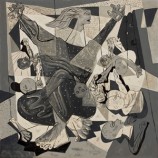
Ur, homeland of Abraham, for those who like crossword puzzles was, until recently, considered to be the oldest known city. Today Jericho is now considered the oldest. The age difference between them is approximately 4,000 years.
In the case of urban waste, according to what I found on the Internet, was that in Jericho, ten thousand years ago there was a very ‘complex’ system of garbage collection. When the people threw away everything that didn’t serve at home anymore the King ordered to collect and pile it all up outside of the city walls.
In Ur, 4,000 years later, another king, Hamurabi, had a stroke of genius. He arranged for all the city’s artisans put aside all scrap that they generated. The shoemaker in turn agreed to take back all the old shoes after they had stepped on the nail one too many times. It was common for someone to walk into a cobbler’s workshop in those days and see piles of old leather in the storefront, of which the children begged for strips of to make slingshots and wrist rockets. The old flaps were also used to make belts and ropes.
The bamboo basket maker reserved all his leftover scraps and passed it over to the soap makers which they used to strain out the raw material goods consisting of ashes from wood stoves and discarded tallow from the butcher.
The town’s tailors and seamstresses also collaborated by accepting back pieces of worn out clothing. The buttons were taken out and reused while the fabrics were cut into rectangular pieces and then reconstructed into charming multicolored quilts. They were great for bed covers. Kept in the old sewing closet of every house were always scraps of cloth, useful for mending torn clothing.
Pages and pages could be filled to record all the dealings made between the artisans and Hamurabi, but I can assure you that, in that modern town, the royal treasurer knew little or nil of these affairs.
Time went by and immediately in civilized Rome we saw a regression. The Emperor, to please the patricians, sent out to collect the garbage from their doorsteps and transported it to the peripheral landscapes, similar to the garbage heaps of Jericho.
Since then we have evolved very little, keeping ourselves in the same state of affairs as the early years in Jericho. Every day or two the trucks pass by the front doors to retrieve the inundation that the residents deposit onto the sidewalks.
It is time that we advance. We can look to Ur for the Reverse Logistics in obtaining the collaboration of the factories and commercial establishments that inundate our cities frenetically with endless packaging and rubbish.

Who knows if visiting the supermarket owners and presenting this idea, we get them to collaborate, accepting back part of the enormous quantities of materials that end up left out on the streets or taken to infected terrains for a prolonged decomposition.
First thing tomorrow I’ll pay a visit to my friend, Zé Nogueira, one of the owners of the chain of supermarkets EPA, Mart Plus and Via Brasil, and make the proposal for him to be a pioneer and put the advantages of ecological marketing into his favor.
If he and his colleagues collaborate we will advance 4.000 years from the present model copied from Jericho, to the Reverse Logistics practiced by Hamurabi.
Related Articles












